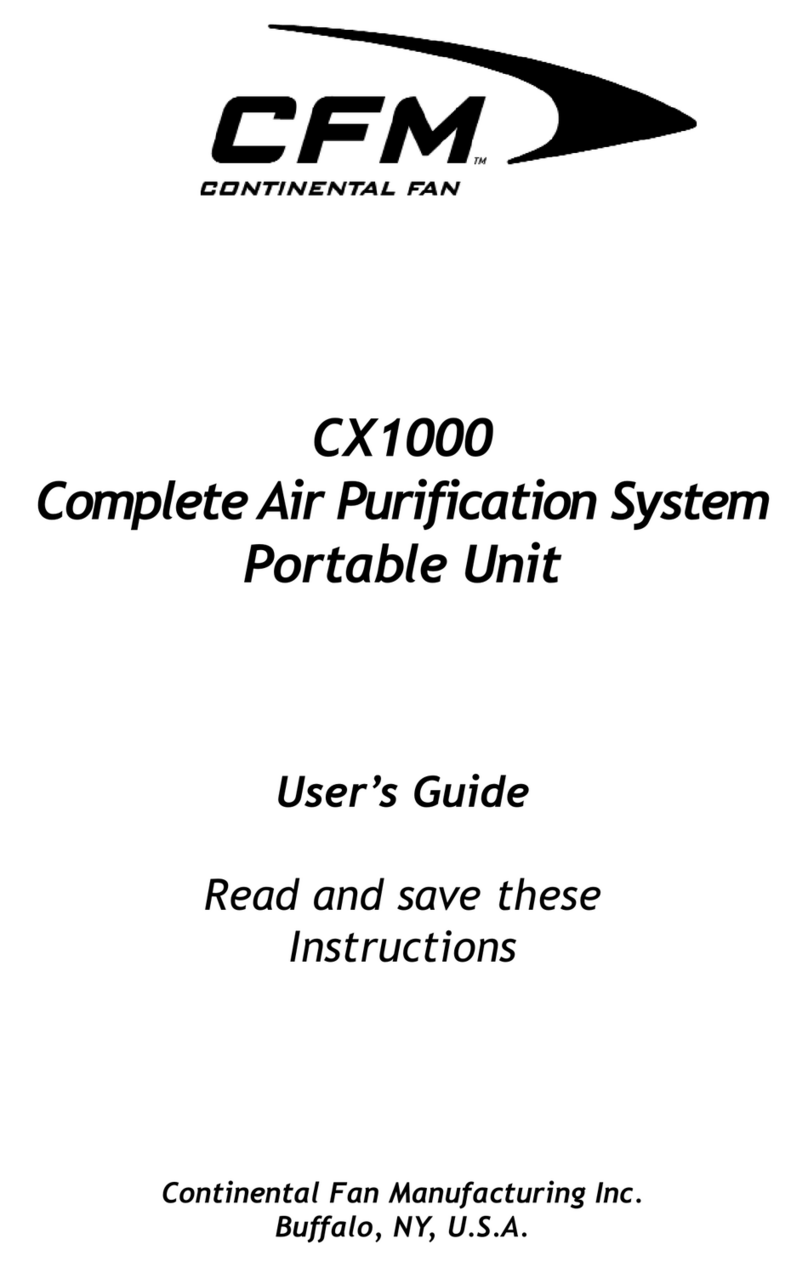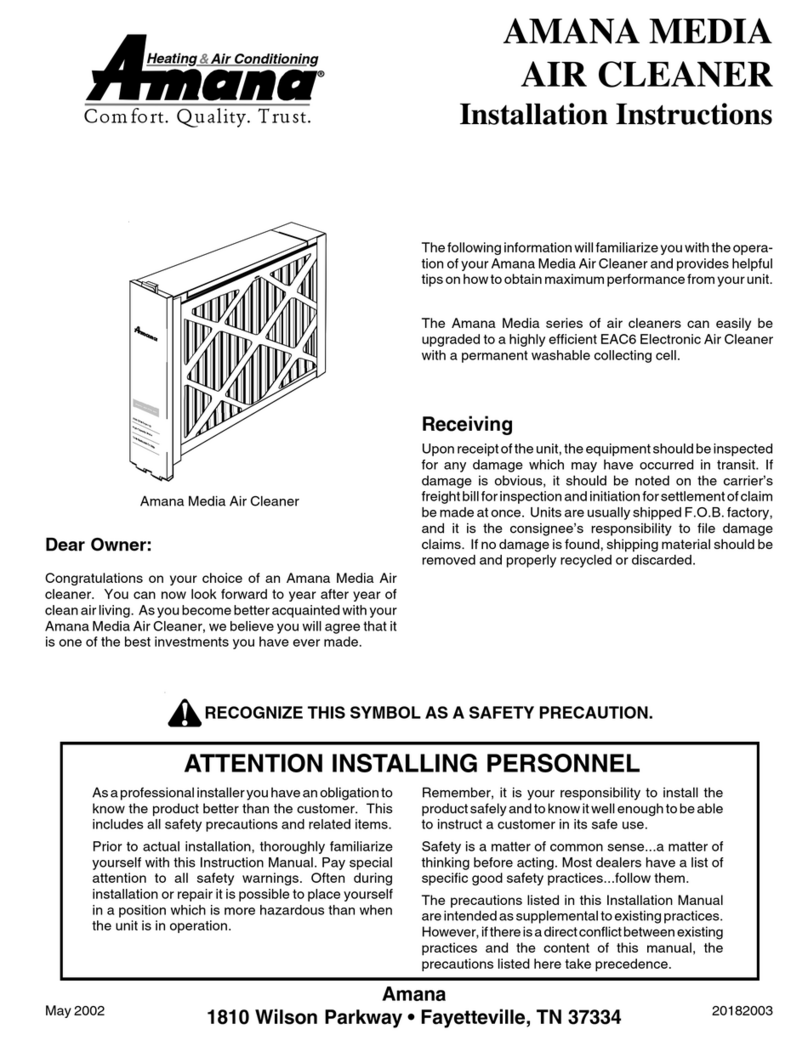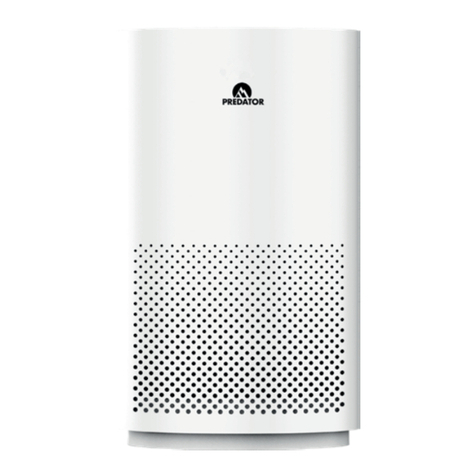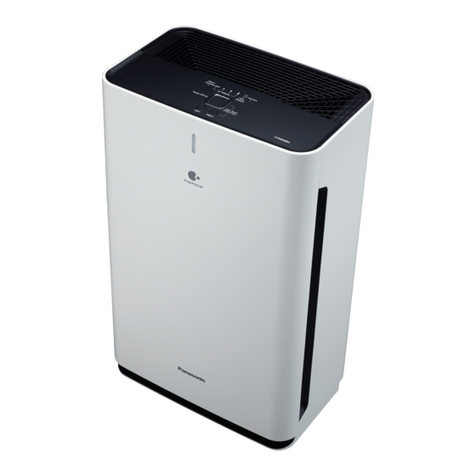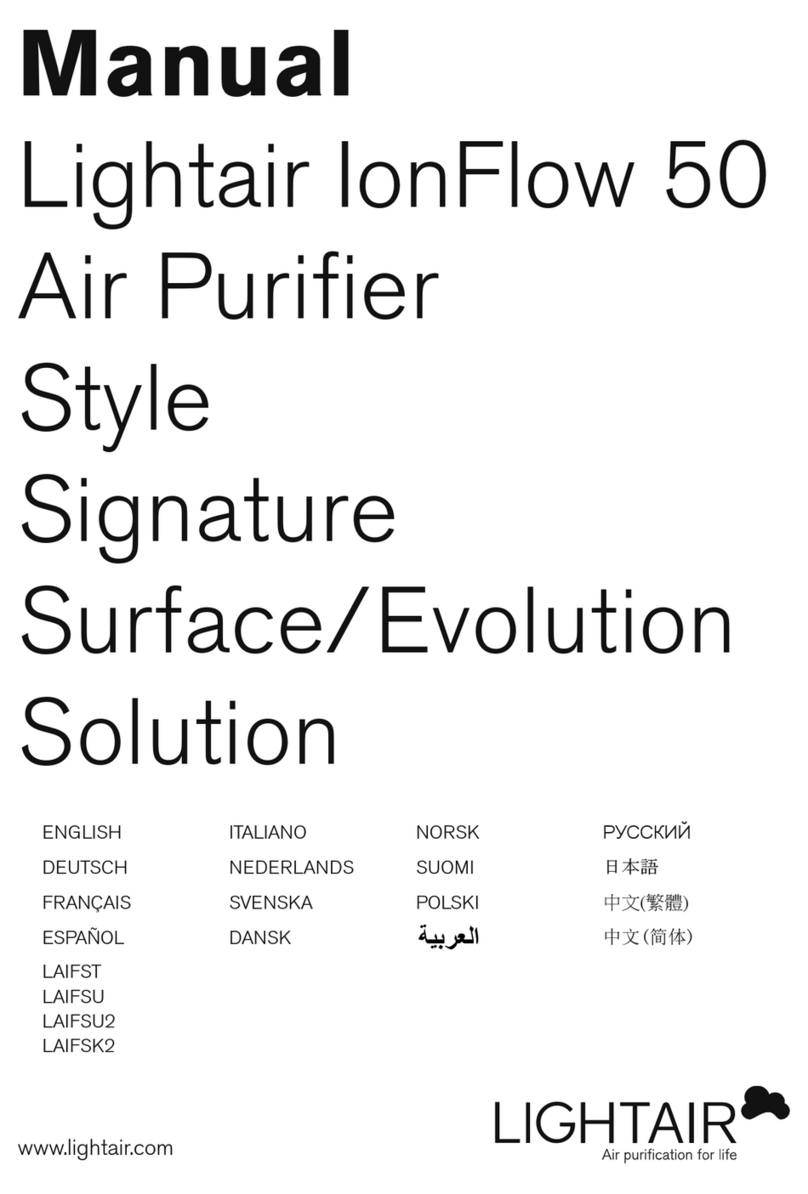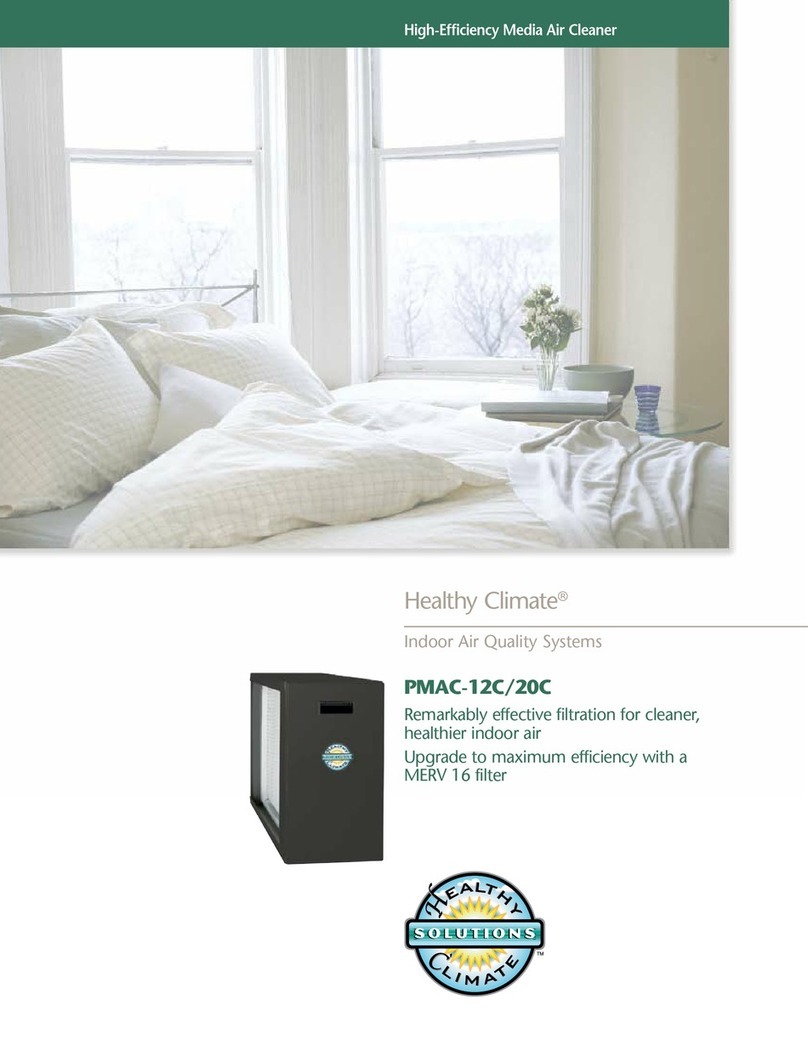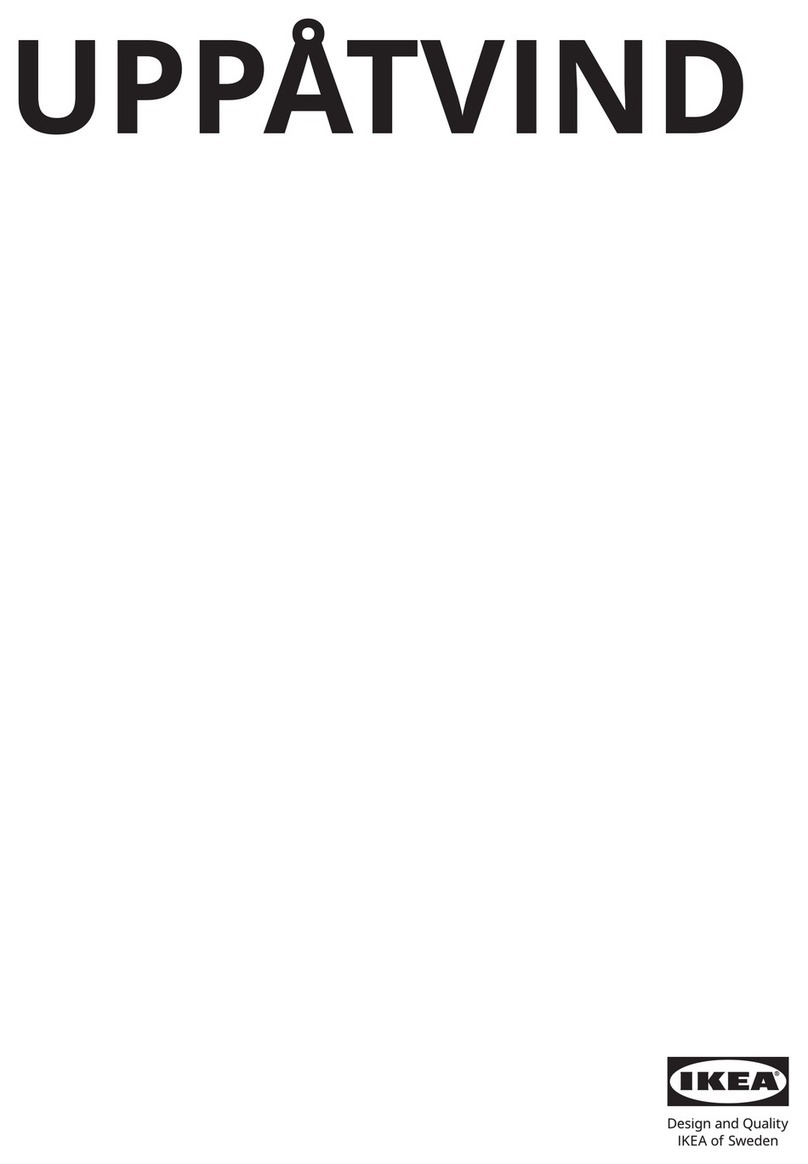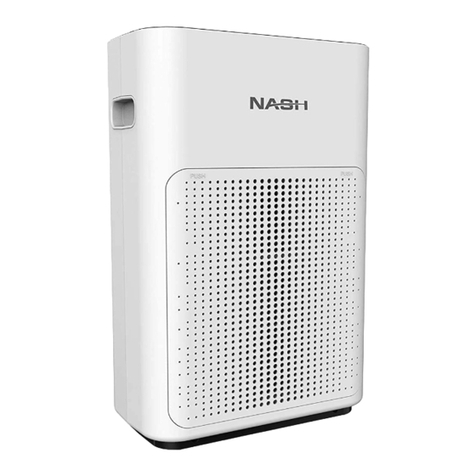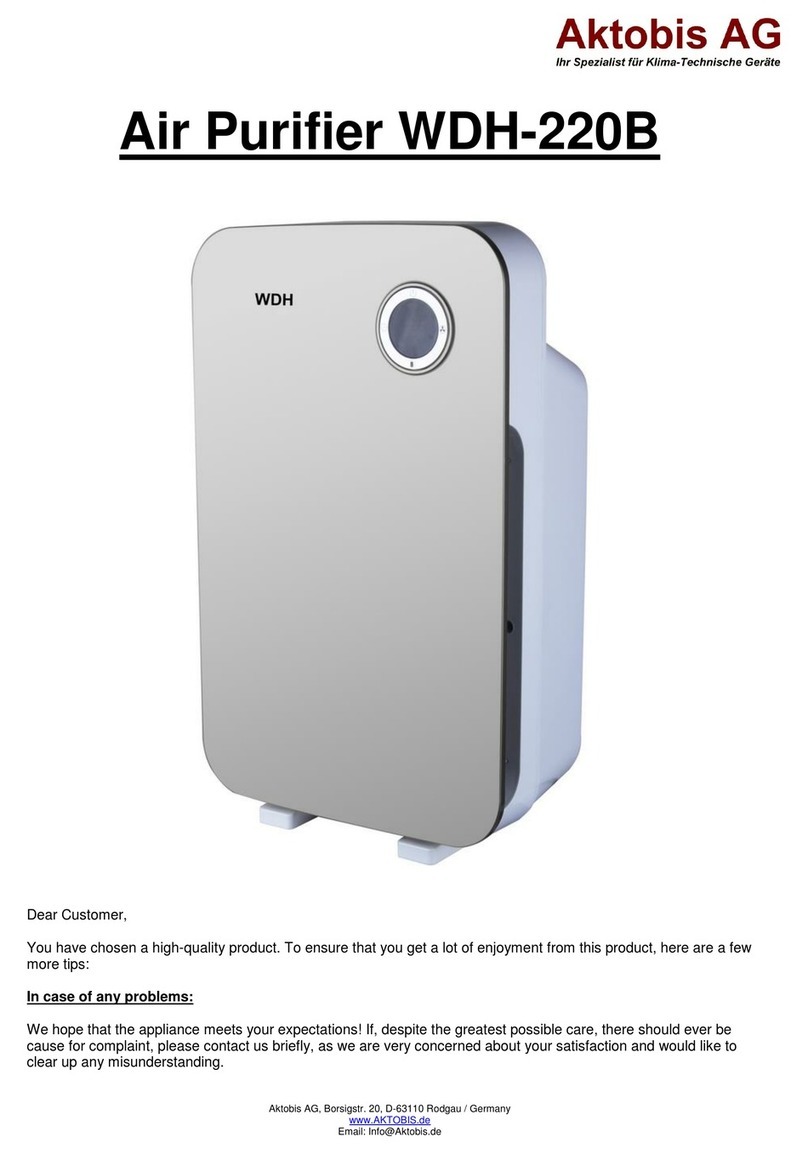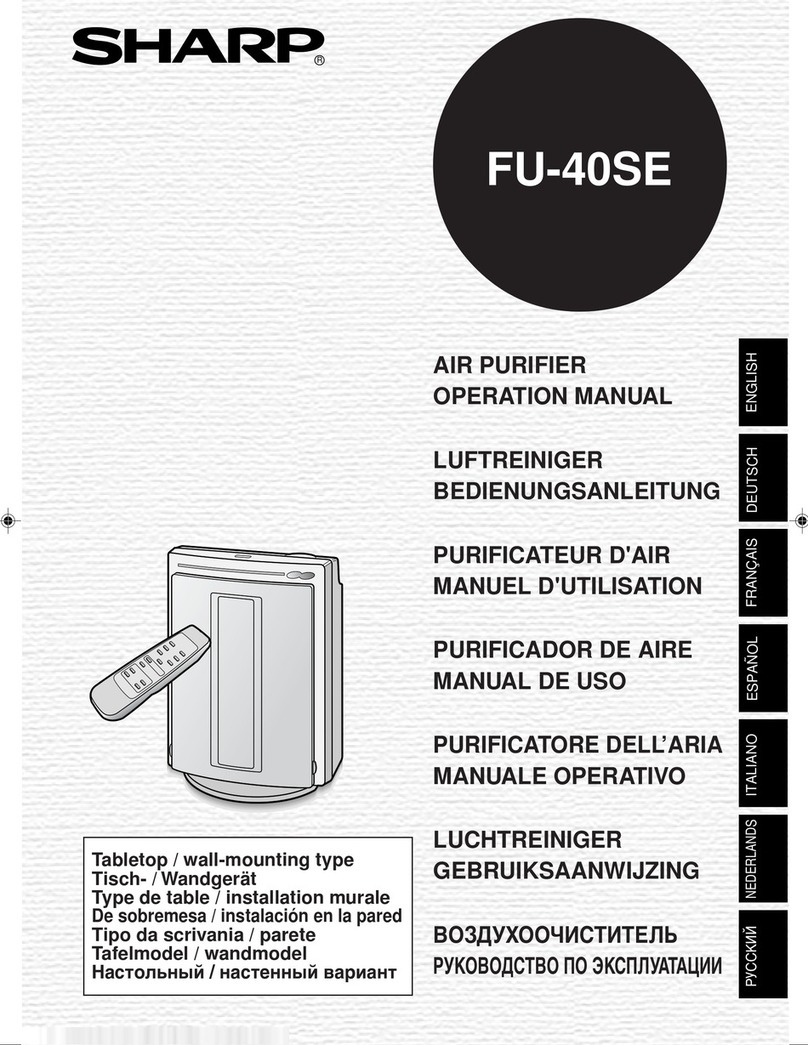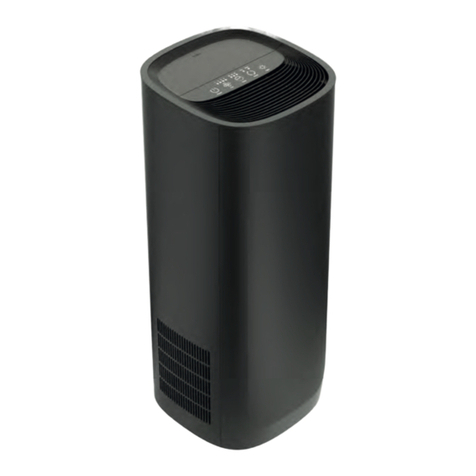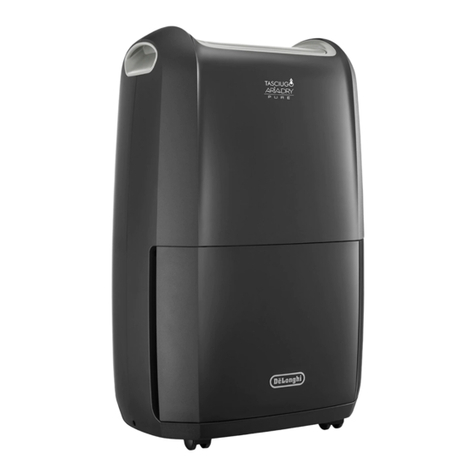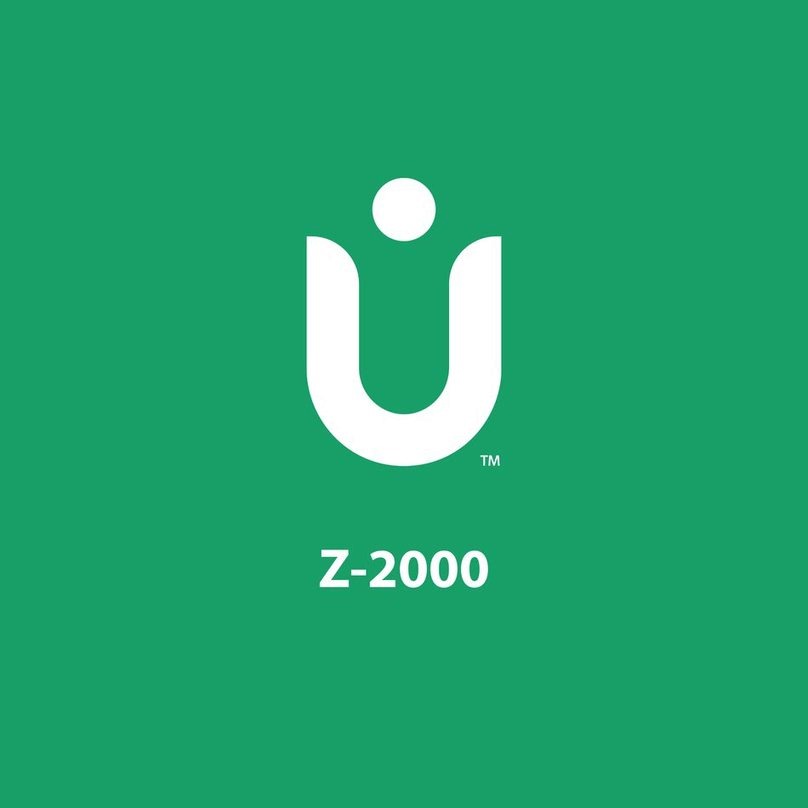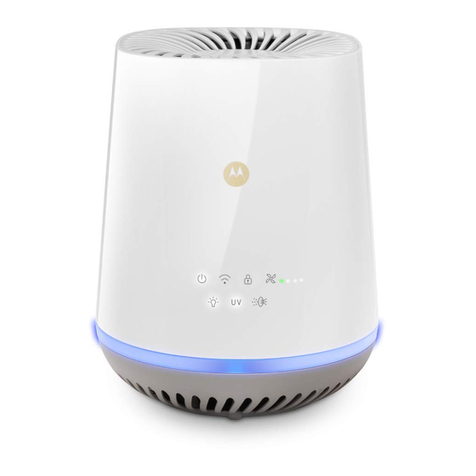INDUSTRIAL MAID AZTech RH 60 Series User manual

1
Owners Manual
AZTech Model RH 60 SERIES
WELDING HOOD - AIR CLEANER

2
Contents
Safety/Inspection ........................................................... 3
Specications................................................................. 4
Installation...................................................................... 5
Replacement Parts ........................................................ 6
Direct Drive Replacement Parts..................................... 8
Electrical ........................................................................ 9
Filter Maintenance ......................................................... 10
Troubleshooting ............................................................. 15
Warranty ........................................................................ 20
Appendix........................................................................ 23

3
SAFETY
PLEASE READ THE FOLLOWING INSTRUCTIONS CAREFULLY BEFORE INSTALLING,
OPERATING OR SERVICING YOUR AIR CLEANER. IT IS THE USER’S RESPONSIBILITY TO
BECOME FULLY AQUAINTED WITH THE CONTENTS OF THE MANUAL AND THE PROPER
OPERATION OF THE EQUIPMENT PRIOR TO USE.
Follow all building and safety codes when installing this equipment. Pertaining but not limited to,
the Occupational Safety and Health Act (OSHA), National Electric Code (NEC), Uniform Building
Code (UBC), National Fire Prevention Act (NFPA) & all state and local codes.
All electrical connections should be performed by a qualied electrician.
Keep Flammable Objects away from the air cleaner and under no condition should a burning
object be allowed into the air cleaning system.
Do not mix materials collected in your Air Cleaner. Materials collected could create a hazardous
environment or a condition of operation for which the equipment was not intended. The
Manufacturer is relieved of any liability if this unit is not used according to this manual.
Do not use the air cleaner for an application other than for which it was intended. Consult your
distributor, Applicable Codes, or call Industrial Maid for application assistance.
Fire protection is not included. Please consult your local re protection specialist for any required
extinguishing equipment.
Consult with your insurance underwriter about any other protection from re damages.
The Manufacturer reserves the right to make design changes which may improve the air cleaner.
This unit is intended for use to collect weld fume, dust, smoke and other airborne pollutants in
industrial and manufacturing Facilities . Do not use for the collection of ammable or explosive
metals, dusts, fumes or other potentially hazardous materials.
INSPECTION
Upon receiving your Industrial Maid air cleaner, please inspect for any damage incurred during
shipment. Inspect carefully; some damage may not be noticeable until the unit is installed. Notify
your shipper of any damage immediately. Claims must be led with the shipper within 15 days.
Freight damage claims are the responsibility of the purchaser.

4
Cabinet 14 ga powder coated steel frame
16 ga powdercoated steel panels
Size/Weight
RH60-2 - 36.5”H x 144”L x 63”D 1025 lbs
RH60-3 - 36.5”H x 144”L x 87.5”D 1670 lbs
RH60-4 - 36.5”H x 144”L x 112”D 2290 lbs
Power STD. - 208-230/460/3/60 13.9-13.4/6.7 amps
OPT. 7.5 HP- 208-230/460/3/60 20-19/9.5 amps
Air Volume 6500 CFM @ .75” W.G
Motor STD. - 5 HP 208-230/460/3/60 TEFC, wired to junction Box
OPT. - 7/5 HP 208-230/460/3/60 TEFC , wired to junction Box
Blower STD.- (1) 12 x 12 Belt Drive
Exhaust Four Way adjustable louver
Filters
1st Stage - (4-8) Galv. Bafe Filters
2nd Stage - (4-8) 24 x 24 x 4, 45% Pleats
3rd Stage - (4-8) 24 x 24 x 21, 95% Bags
Warranty 3 year limited warranty
SPECIFICATIONS
Figure 1 (RH60-3 shown)

5
INSTALLATION
The system’s weight must be taken into account when choosing the proper installation method
(see specication). Follow all applicable building and electrical codes.
The RH60 Series Hood Assembly comes with (4) eyelets for rod hanging the system or can be
oor mounted with optional column support assembly. When using the eyelets for hanging, it is
critical that you do not angle the support rods, they must be installed straight above the eyelet to
maintain the integrity of the eyebolt. See Figure 2 below. For complete Assembly drawing and
parts list, refer to appendix.
Mounting materials must be able to support the weight of the air cleaner plus the additional
weight of the material collected. Consult your local building code for proper installation methods
and materials. Failure to use the proper materials could result in injury or damage equipment
and will void the warranty.
HEIGHT REQUIREMENTS
To insure worker and building safety, Industrial Maid recommends that RH series hoods be
mounted a MINIMUM of 5 ft or greater above the highest point of arc in welding applications.
The hoods are designed with a low intake velocity and spark bafe to avoid capturing sparks and
ammable debris generated during the welding process. Failure to maintain a safe distance
from the welding arc can result in unsafe operating conditions, injury or property damage.
Consult with your distributor , Insurance underwriter and local re authority to insure a safe
installation.

6
REPLACEMENT PARTS
ITEM PART NUMBER QTY DESCRIPTION
1 BW12-AA12 1 BELT DRIVE BLOWER ASSEMBLY
2 MT05-2431-SG 1 5 HP 208-230/460/3/60 TEFC MOTOR
3A 3X591 1 5 HP - VARIABLE SHEAVE DRIVE PULLEY
3B 3X593 1 7.5 HP - VARIABLE SHEAVE DRIVE PULLEY
4 PT07-0778 1 BLOWER PULLEY
5 PT0A-0055 1 A55 V BELT
6A 00060-11CS 2-5 16 GA. POWDERCOATED PANELS - TOP & SIDE
6B 000060-10CS 1 16 GA. POWDERCOATED PANELS - EXHAUST
6C RH60-12-RHAP 1 16 GA. POWDERCOATED PANELS - MOTOR ACCESS
7 FR60-ASSY 2-4 14 GA. FRAME ASSEMBLY
8 GR09-0016 1 4-WAY ADJUSTABLE EXHAUST GRILLE
9A FB91-2424 4-8 95% FIBERGLASS BAG FILTER *
9B FB61-2424 4-8 (OPT) 65% FIBERGLASS BAG FILTER *
10 FP44-2424 4-8 4” PLEATED PREFILTER
11A BF02-2424 4-8 2” GALVANIZED BAFFLE FILTER
11B FA02-2424 4-8 2” ALUMINIUM MESH FILTER
12 RH60-ASSY 2-4 MAIN HOOD FRAME ASSEMBLY

7
ITEM PART NUMBER QTY DESCRIPTION
13 003560-RHC 4 HOOD CORNER
14 003560-RHE 2 HOOD END SECTION
15 003560-RHS 4 HOOD SIDE
16 RH3560-1H-02 4-8 PLENUM FRAME
17 LL-4T54N-C-3 2 48” DUSTPROOF LED LIGHT KIT
18 MT05-184M 1 MOTOR BASE
19 354580-PL1CS 8-12 16 GA. STEEL PLENUM SIDE PANELS
20 354580-PL2CS 4-8 16 GA. STEEL PLENUM END PANELS
21 RH3560-1H-01 4-8 FILTER ACCESS DOOR W/ HINGE
22 62-10-35 4-8 LATCH FOR FILTER ACCESS DOOR
* FILTER EFFICIENCIES BASED ON ASHRAE TEST METHODS

8
OPTIONAL DIRECT DRIVE REPLACEMENT PARTS
ITEM PART NUMBER QTY DESCRIPTION
1 MT05-2433 1 5.0 HP 208-230/460/3/60 TEFC MOTOR
2 BWBI-T355 1 TEK 355 COMPOSITE BI WHEEL
3 ICBI-T355 1 TEK 355 INLET CONE
4 M36V-D-355 1 DIRECT DRIVE MOTOR CABINET - 5HP
5 GR018-0018 1 18X18 EXHAUST GRILLE
6 HD35-44ST 1 MOTOR ACCESS PANEL
7A RH35-DD12 1 RH60-2 DIRECT DRIVE TRANSITION
7B RH35-DD13 1 RH60-3 DIRECT DRIVE TRANSITION
7C RH35-DD14 1 RH60-4 DIRECT DRIVE TRANSITION

9
ELECTRICAL WIRING
Unit comes wired to a junction box Additional wiring will be required to get power to unit, which is not
supplied with this product.
Motor Starters, disconnects, wiring, overloads, and thermal protection are NOT provided by the
Manufacturer
All Field wiring should be performed by a qualied electrician and must meet all local and NEC codes.
Failure to install the proper electrical wiring, thermal protection, and controls will void the warranty.
ROTATION - On single phase units motor rotation can be reversed by switching the black and red leads
in the motor, always refer to motor nameplate when switch leads for rotation. Three phase motors can be
reversed by switching leads L1 and L2. VERIFY rotation before operating the air cleaner to avoid over
amping the motor, voiding warranty.
After completion of the eld wiring, turn the unit on to check for proper rotation. Rotation is marked on the
side of the blower housing for the standard forward curve blower. Optional direct drive BI blower wheels
will rotate in a clockwise direction when looking at the top of the motor, or the wheel should be spinning
from right to left as viewed through the exhaust grid. Backward rotation will result in a much lower air
ow, louder noise, and will over amp the motor. Check the motor nameplate before switching wires and
reversing rotation, to ensure the unit is operating at or below rated full load amp draw. Figure 6 illustrates
how to identify the proper rotation.
Figure 6 - Blower Rotation

10
FILTER MAINTENANCE
METAL PRE-FILTERS - Standard RH Series hoods area supplied with a 2” spark bafe inlet. Part
BF02-2424. Inlet bafes shall be kept free of oil, ammable debris and particulate at all times.
Bafes should be removed and washed as soon as noticeable build up of particulate (discoloring)
occurs. Visually inspect the metal pre-lters weekly to determine if they should be cleaned. To
remove the bafes, simply slide out of the pre-lter tracks located on the underneath side of the hood.
Bafe are galvanized steel and can be rinsed with warm water or mild detergent. Allow to dry and
replace.
Some applications may require the optional aluminum mesh pre-lter, FA02-2424. Due to the nature
of the tight woven pattern of the aluminum mesh, particulate build up may be accelerated, thus
requiring more frequent cleaning. Aluminum Mesh lters shall be kept free of oil, ammable debris
and particulate at all times. Industrial Maid recommends washing aluminum mesh lters as soon as
noticeable buildup of particulate or discoloring occurs. Visually inspect the metal pre-lters weekly to
determine if they should be cleaned. Aluminum mesh lters are to be removed and rinsed with warm
water or mild detergent. Allow to dry and replace.
The Metal Pre-lters supplied by the factory are not a re hazard. Failure to properly maintain
all lters can allow for the buildup of ammable materials in some applications. Proper lter
maintenance must be maintained for the safe operation of the RH series hood.
PLEATED PREFILTERS - The RH Series hoods are supplied with a standard 4” pleated pre-
lter (FP44-2424), rated Class 2 under UL standard 900 & operating temperature of 180 degrees
Fahrenheit. Filter life for replaceable media varies greatly per application. Industrial Maid
recommends a monthly service interval consisting of a visual inspection of the pleated pre-lters,
replacing as needed.
MAIN BAG FILTERS - The RH Series hoods are supplied with a standard 95% efcient extended
surface berglass bag lter, rated Class 2 under UL standard 900 & operating temperature of 180
degrees Fahrenheit. Filter life for the Main Bag Filter varies greatly per application. Bag lters
should be serviced when the pressure drop across the bag lters reach 1” w.g.
Pressure drop is best measured by installing a lter service gauge (manometer or magnahelic
pressure gauge), available from Industrial Maid. With clean lters and the gauge properly installed,
make note of the reading on the pressure gauge. Add 1” to that number, this is will give you the point
at which the lters need serviced. Replace accordingly.
Failure to properly maintain all lters can allow for the buildup of ammable materials in some
applications. Proper lter maintenance is required for the safe operation of the RH series hood.
SAFETY AFTER FILTERS - The RH series is available with an optional HEPA after lter system.
HEPA lters are rated at 99.97% efcient, 180 degree Fahrenheit & Class 2 under UL std. 900. For
safety purposes, HEPA lters should be replaced every 12 months or when the pressure drop across
the media increases by 1.0” w.g. , whichever comes rst.

11
Motor 25 to 50 Feet 100 Feet 150 to 200 Feet
HP 200V 230V 460V 200V 230V 460V 200V 230V 460V
1/3 14 14(16)* 14(18)* 12 12 14(18)* 8 10 14(18)*
1/2 14 14(16)* 14(18)* 12 12 14(18)* 8 10 14(18)*
3/4 14 14(16)* 14(18)* 12 12 14(18)* 8 10 14(18)*
1 14 14(16)* 14(18)* 12 12 14(18)* 8 10 14(16)*
1 1/2 12 14 14(18)* 10 10 14(16)* 6 8 14
2 12 12 14(18)* 8 10 14(16)* 6 6 12
3 10 12 14(18)* 6 8 14 4 6 12
5 8 10 14(16)* 4 6 12 2 4 10
7 1/2 6 8 14 4 4 10 1 2 8
10 6 6 12 3 4 10 1/0 1 6
15 4 4 10 1 2 8 3/0 2/0 4
20 3 4 10 1/0 1 6 4/0 3/0 4
25 2 3 8 2/0 1/0 6 250kcmil 4/0 3
30 1 3 8 3/0 1/0 6 300kcmil 4/0 3
40 1/0 1 8 4/0 3/0 4 400kcmil 300kcmil 1
50 2/0 1 6 250kcmil 3/0 3 500kcmil 350kcmil 1
60 3/0 1/0 6 300kcmil 4/0 3 600kcmil 400kcmil 1/0
75 4/0 2/0 4 350kcmil 250kcmil 2 700kcmil 500kcmil 2/0
100 250kcmil 3/0 4 500kcmil 350kcmil 1 900kcmil 700kcmil 3/0
125 300kcmil 4/0 3 600kcmil 400kcmil 1/0 1250kcmil 800kcmil 4/0
150 350kcmil 250kcmil 2 700kcmil 500kcmil 2/0 1500kcmil 900kcmil 250kcmil
200 500kcmil 350kcmil 1/0 1250kcmil 800kcmil 4/0 1750kcmil 1250kcmil 350kcmil
250 600kcmil 400kcmil 2/0 1500kcmil 900kcmil 250kcmil 2000kcmil 1500kcmil 400kcmil
MOTOR MOUNTING
Motor must be securely fastened to a rigid, at surface to prevent vibration and minimize noise.
For secure mounting use high-quality bolts of the largest possible diameter.
Belt-drive sheaves must be in-line. Use a straight edge to check. Do not over-tighten belts.
Direct coupled installations require a careful check of shaft and coupling alignment, shaft offset
and/or angular misalignment should be less than .002”. Shim motor base as necessary. Do not
depend on a exible coupling to compensate for misalignment.
Table A - Minimum Wire Sizes for 3- Phase Motors
NOTE: kcmil denotes thousand circular mils. AWG sizes formerly given in MCM.
(*) Type S, SO, SJ, SJO, etc. exible cable wire sizes. See NEC article 400 for ampacity.

12
CONNECTING POWER TO MOTOR
To connect motor for proper voltage and rotation, refer to the connection diagram on the
nameplate or inside the terminal/conduit box.
Motor 25 Feet 50 Feet 100 Feet 150 Feet 200 Feet
HP 115V 230V 115V 230V 115V 230V 115V 230V 115V 230V
1 10 14(16)* 6 12 4 10 2 8 1 6
1 1/2 8 14 6 12 3 8 1 6 1/0 6
2 8 14 4 10 2 8 1/0 6 2/0 4
3 6 12 3 8 1/0 6 2/0 4 4/0 3
5 - 10 - 6 - 4 - 2 - 1
7 1/2 - 8 - 6 - 3 - 1 - 1/0
10 - 8 - 4 - 2 - 1/0 - 2/0
Table B - Minimum Wire Sizes for Single Phase Motors
* Type S, SO, SJ, SJO, etc. Flexible cable wire sizes. See NEC Article 400 for ampacity.
NOTE: NEC Article 310-5 --- Minimum conductor size for general wiring at 115-440VAC is
No. 14AWG.Above wire sizes based on approximate 5% voltage drop during starting; copper
conductors; and 75° C type THHW, THW, THWN, RH, RHW insulation, etc. For aluminum
wire, increase two wire size steps minimum. See NEC Article 310 for ampacities of aluminum
conductors.

13
RECOMMENDED MAINTENANCE
WARNING
All aspects of the installation must conform to the requirements of
the NEC, including Article 430 (Motor circuits and Controllers), and all
local codes.
Wherever possible, each motor should be powered from a separate circuit of adequate capacity
to keep voltage drop to a minimum during starting and running. Increase wire size where motor is
located a distance from the power source. Wire size must be adequate to minimize voltage drop
during starting and running. Refer to Tables A and B for suggested wire sizes. Distances shown
are one-way between source and motor. Portable cords, if used, should be as short as possible
to minimize voltage drop. Long or inadequately sized cords, especially on hard starting loads, can
cause motor failure. All electrical connections in system must be secure to prevent voltage drop
and localized heating.
• Determine direction of rotation before connecting driven equipment to prevent damage.
• To prevent bearing damage, do not strike shafts with hammer or other tool.
• If the motor has been damp or wet, then have motor serviced by a qualied motor repair
shop before operating.
Recommended Maintenance
Remove dirt accumulations in and around vent openings, by vacuuming. Dirt accumulations
can cause motor overheating and a re hazard. Enclosed motors can be cleaned with an air
jet; wear eye protection.
Periodically inspect the installation. Check for dirt accumulations; unusual noises or vibration;
overheating; worn or loose couplings, sheaves and belts; high motor current; poor wiring or
overheated connections; loose mounting bolts or guards; and worn motor starter contacts.
Dayton ball-bearing motors without lubrication provision do not require periodic relubrication.
Where motor has provision for bearing lubrication, lubricate as follows:
1. After stopping motor and disconnection power, thoroughly wipe the housing around both of
the motor bearings, ller and drain plugs (on TEFC) ratings, remove fan cover for access
to plugs).
2. Remove ller and drain plugs and install a 1/8” pipe thread lube tting in ller hole.
3. Using a low pressure grease gun, pump new grease into motor until it appears at the drain
hole.
4. Run motor for several minutes to discharge excess grease. Shut motor OFF, replace ller
and drain plugs, and reinstall fan cover.
See Table C for suggested regreasing intervals.

14
MOTOR HP AT 1800 RPM MAX
TYPE OF SERVICE UNDER 50 50 TO 100 OVER 100
Infrequent operation or light duty in clean atmosphere 2 Years 2 Years 1 Year
8 to 16 hours per day in clean, relatively dry atmosphere 2 Years 1 ½ Years 1 Year
12 to 24 hours per day heavy duty use, or if moisture is
present
1 Year 1 Year 6 months
Heavy duty use in dirty, dusty locations; high ambients;
moisture laden atmosphere; constant vibration
4 Months 4 Months 3 Months
NOTE 1: Motors operating faster than 1800 RPM should be relubricated on a more frequent
maintenance schedule. Use a reputablebrand lithium or synthetic-base grease intended for electric
motor ball bearings. Recommended greases include: Standard Oil of California (Chevron) SRI#2,
and Exxon Corp. PolyRex-EM. Keep grease container clean and covered.
Table C – Suggested Regreasing Intervals

15
MOTOR TROUBLESHOOTING
This chart suggests common answers to electric motor problems. The information is not
all-inclusive and does not necessarily apply in all cases. When unusual operating conditions,
repetitive failures, or other problems occur, consult an electric motor service rm.
Symptom Possible Cause(s) Corrective Action
Motor fails to start 1. Blown fuses 1. Replace with time-delay fuses.
Check for grounded winding
2. Voltage too low at motor
terminals due to line drop
2. Consult local power company.
Increase wire size (refer to
Tables A & B). Check for poor
connections
3. Overload in motor starter tripped 3. Check and reset overload
relay in starter. Check heater
rating against motor nameplate
current rating
4. Overload (internal thermal
protector) tripped
4. Check motor load. If motor
has an automatic or manual
reset thermal protector, check
if tripped
5. Improper line connections 5. Check connections against
diagram supplied with motor
6. Motor may be overloaded 6. Reduce load or increase motor
size
Motor does not come up to
speed or takes too long to
accelerate
1. Not applied properly 1. Consult motor service rm for
proper type. Use larger motor
2. Voltage too low at motor
terminals
2. Increase wire size (refer to
Tables A & B). Check for poor
connections. Check for voltage
unbalance (3-Phase)
3. Starting load to high 3. Check load motor is carrying at
the start
4. Excess loading; tight belts 4. Reduce load; increase motor
size. Adjust belts

16
Symptom Possible Cause(s) Corrective Action
5. Defective motor. 5. Replace or repair
6. Inadequate starting torque. High
inertia load
6. Replace with a larger motor
Motor stalls during
operation
1. Overloaded motor 1. Reduce load or increase the
motor size
2. Low motor voltage 2. Verify that nameplate voltage is
maintained
Motor vibrates or is
excessively noisy
1. Motor shaft is misaligned 1. Realign
2. 3-phase motor running on single
phase
2. Check for open circuit, blown
fuses or unbalanced voltages
3. High or unbalanced voltages 3. Check wiring connections.
Consult local power company
4. Worn, damaged, dirty or
overloaded bearings
4. Replace bearings; check
loading and alignment
5. Defective winding. Bent or
bowed shaft
5. Repair or replace
6. Loose sheave or misaligned
coupling
6. Tighten set screw(s); realign
coupling
Motor overheats while
running under load
1. Overloaded 1. Reduce load; increase motor
size; belts may be too tight
2. Dirt blocking ventilation openings 2. Clean motor
3. If 3-Phase, one phase may be
open
3. Check lines for open phase.
Check voltage with motor
disconnected, one fuse may be
blown.
4. Unbalanced supply voltage 4. Check for faulty connections.
Voltage on all three lines
should be balanced within 1%.
Balance single phase loads.
5. Faulty connection 5. Clean, tighten, or replace
6. High or low voltage 6. Check voltage at motor, should
not be more than 10% above or
below rated
7. Defective motor 7. Repair or replace

17
BLOWER OPERATION
After electrical connections are completed, start motor briey to determine the direction of wheel
rotation. If necessary to reverse the rotation, follow instructions given on the motor nameplate or
terminal box cover.
With air system in full operation, and with all ducts attached and inspection door(s) closed, measure
the current input to the motor and compare with nameplate rating to determine if the motor is
operating under safe load conditions.
Blower Maintenance
1. After electrical connections are completed, start motor briey to determine the direction of
wheel rotation. If necessary to reverse. The rotation, follow instructions given on the motor
nameplate or terminal box cover.
2. Follow motor manufacturer’s instructions for motor lubrication. Remove excess lubricant.
3. Follow Replacement Parts Manual for blower bearing lubrication.
4. Check wiring to make sure it is secure and well insulated
BLOWER TROUBLESHOOTING CHART
Symptom Possible Cause(s) Corrective Action
Excessive noise and/or
vibration
1. Foreign object 1. Remove
2. Wheel rubbing on housing 2. Center the wheel
3. Loose wheel or sheave on
shaft
3. Tighten all set screws
4. Motor or blower not secure 4. Tighten Mounting
5. Belt(s) too loose/too tight 5. Adjust Tension
6. Worn belt(s) 6. Replace
7. Mismatched belt(s) 7. Replace
8. Loose or worn bearings 8. Replace
9. Bearing or drive alignment 9. Realign
10. Accumulation of material on
wheel
10. Clean
11. Motor out of balance 11. Replace
12. Wheel out of balance 12. Replace or Re-balance
13. Sheaves eccentric or out of
balance
13. Replace

18
Symptom Possible Cause(s) Corrective Action
Insufcient air ow 1. Blower speed too low 1. Check for correct drives
2. Dampers or registers closed 2. Open
3. Dirty or clogged lters 3. Clean or replace
4. Leaks in duct work 4. Repair
5. Elbows, cabinet walls, or other
obstructions
5. Correct
6. Belt slippage 6. Adjust or replace
Too much air ow 1. Blower speed too high 1. Check for correct drives
2. Filter(s) not in place 2. Install lter(s)
Unit fails to operate 1. Blown fuse or open circuit
breaker
1. Replace fuse or reset circuit
breaker
2. Broken fan belt 2. Replace
3. Defective motor and/or
capacitor
3. Replace
Motor overloads or overheats 1. Blower speed too high or motor
horsepower too low
1. See Speccations for correct
drives and HP
2. System static pressure too low 2. Check static pressure and
correct syst
3. Shorted windings in motor 3. Replace

19
SERVICE RECORD
Date Description Serviced By Location Comments
351 S. 12th Rd.
Cortland, NE 68331
Ph. (402) 798-7116
Fx. (402) 798-7117
www.industrial-maid.com
START UP DATA: (write down for future reference)
MODEL NUMBER____________________________ SERIAL NUMBER_______________________
HP________________________ VOLTAGE____________________MFG. DATE__________________
VOLTAGE - L1_______________________L2________________________L3____________________
AMP DRAW - L1______________________L2________________________L3____________________
OTHER NOTES: ______________________________________________________________________
_____________________________________________________________________________________
PRESSURE GAUGE READING(AT START UP)____________________________________________

20
WARRANTY
1. Limited Product Warranty. Industrial Maid, LLC, 351 S. 12th Rd., Cortland, NE, 68331, hereby
warrants to any owner who has purchased the equipment other than for purposes of resale, as
follows:
A. All components of air cleaners and air ltration equipment manufactured (collectively
“Components”) by Industrial Maid, as well as motors and drives installed on Industrial Maid
units (collectively “Components”) will be manufactured in conformity with stated materials,
dimensions, and tolerances;
B. Components manufactured by Industrial Maid, as well as motors and drives installed in
Industrial Maid units, will, in normal use and service, be free from defects in material and
workmanship for a period of thirty-six (36) months;
C. Components not manufactured by Industrial Maid (other than motors and drives) are not
included within the thirty-six (36) month Warranty. These excluded items include HMI
Control Panels, motor starters, disconnects, lters, duct work, and installation not supplied by
Industrial Maid. The Limited Product Warranty on these items, when sold by Industrial Maid
as part of the unit, is twelve (12) months and parts only.
D. Upon delivery, Industrial Maid will convey good and marketable title to the Components
to Owner free and clear of all liens and encumbrances other than those arising in favor of
Industrial Maid, including the purchase money security interest.
2. Duration of Warranty/Notice Requirements. The warranties set forth in Section1 above shall
apply to covered defects in Components that are discovered by Owner within the respective
thirty-six (36) months or twelve (12) months following the Invoice Date (the “Warranty Period”)
and are reported to Industrial Maid in writing within thirty (30) calendar days following their
discovery (the “Notice Period”).
3. Exceptions and Exclusions. Notwithstanding anything herein to the contrary, the warranties set
forth in Section 1 above do not cover any of the following, each of which are hereby expressly
excluded therefrom:
A. Defects that are not discovered during the Warranty Period;
B. Defects that are not reported to Industrial Maid in writing within the Notice Period;
C. Usual and customary deterioration or wear resulting from normal use, service and exposure;
D. Consumable items such as lters, belts, and lter hammer are not warranted;
E. Any Components that are installed outside of the United States, Canada, or Mexico, United
Kingdom and European Union;
F. Any xtures, equipment, materials, supplies, accessories, parts, or Components that have
been manufactured and/or furnished by any third party;
G. Any shortages in or damage to any Industrial Maid Components at delivery, all of which shall
be exclusively governed by the invoice or Purchase Agreement;
H. The durability and/or variation in the appearance or color of Components;
I. Any Components which have been removed from the Industrial Maid unit on which they were
originally installed;
J. The effect or inuence any Industrial Maid Components may have on any pre-existing or
other structures, including without limitation, any damage associated with loads imposed by
the Industrial Maid Components on such structures;
Table of contents
Other INDUSTRIAL MAID Air Cleaner manuals



